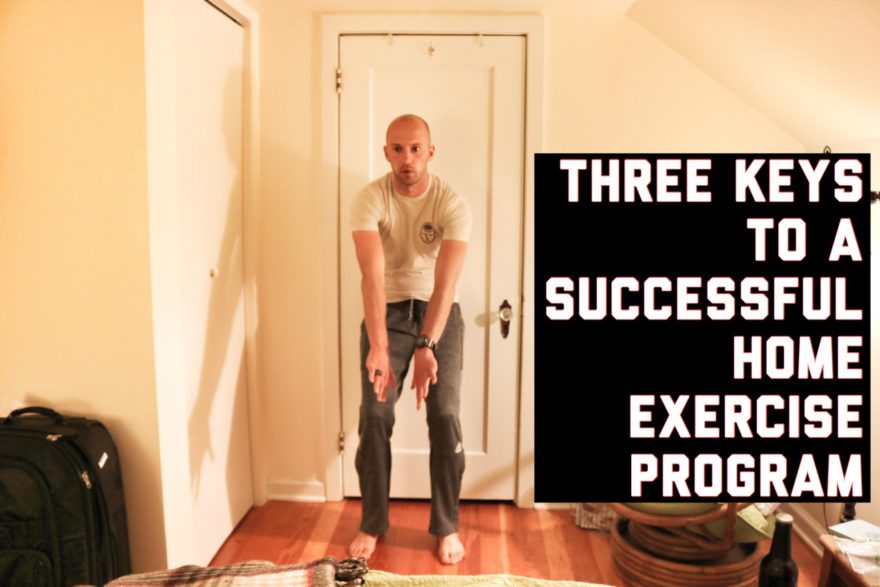I recently had someone ask me about how I get people to do their exercises on the regular at home.
Let’s face it, it can be challenging to have clients succeed if they are not doing the stuff they need to do at home. Only so much can be accomplished in the small portion of time we as clinicians and coaches spend with our clients.
If you follow the steps I have in the podcast and transcript below, you can see home exercise program execution increase substantially.
Enjoy!
Table of Contents
Modified Transcript
We’re going to talk about designing and executing an effective home exercise program that helps your clients reach their goals.
A lot of the keys are on you, my friend; regardless of if you are a coach, clinician, trainer, or nutritionist. I don’t care what you are! If you want your people moving effectively, and you use movement to help them reach their goals, this one’s for you.
Educate on why the home program is important
The first key, first and foremost, is education. You have to educate your people as to why doing activity X is important, and how is it going to help them reach their goals.
Many times you will give an activity in a home exercise program that does not seem related whatsoever to the offending activity. How is this breathing activity going to help me get to the mailbox without pain? How is activity B going to help me lift some heavy things off the floor without pain?
And I get it from the client standpoint. They don’t understand how this seemingly unrelated quality helps them perform the activity that is problematic.
What you have to do is you have to bridge that gap. You have to show them the link. Show them the way.

The way I do it is by showing how the impairment that I’m trying to address. with the home exercise program relates to the activity that they’re having trouble with .
I do a lot of variability based things for my people in regards to their home exercise program. For example, I may say: “Hey you know how you couldn’t move your hip in this fashion? Well a lot of times if you don’t have full range of motion, what that’s going to do is that’s going to alter how you manage your body when you’re doing the offending activity.” Because if you don’t have access to your full movement repertoire at a given joint, your body has to move differently and compensate.”
Most people understand how the body compensates when in pain. Then, I will say “if we can give you something that restores range of motion back that’s got to do is ask and alter how your body manages pressure and load. And if your body manages pressure and load differently than it is now—because let’s not get it twisted fam, your current strategy is working for you—then we’ll have a fighting chance of coaching you to perform the activity that’s problematic without pain.”
A lot of times just doing something as simple as that and showing them how the seemingly unrelated task is linked to the related tasks is important. Because if your clients don’t understand why they’re doing something and why it’s important, they’re not going to do it .
Reduce logistical roadblocks
Another reason why home exercises don’t get done is not because clients are lazy. It’s, but because of logistics.
I’ve had quite a few clients who are older, who can’t get up and down off the ground or have a soft bed. I’ve made the error of giving them an activity that requires them to lie on their back.
When I ask how the home program went, they without fail say they couldn’t do it. When I asked why not, they would give the reasons I listed above; the bed is too soft, the exercise didn’t feel right, and there weren’t any good changes.
Who’s at fault? That’s on me and you big dog.

One thing that I do to mitigate this problem is telling my clients upfront that I’m not married to any exercise. I’ve got a million ways to skin a cat. If for some reason, any reason you can think of—a soft bed, I don’t have a counter to do this on, or the dog barks whenever I’m in that position, whatever—if there’s anything that makes you think you can’t do this at home, let me know. And if it doesn’t work for them, I’m on to something else.
We have to make sure that any potential barrier that the client has is eliminated. Please take into account logistics when you’re designing a program.
Time is another logistical barrier. There are a few ways you can manipulate this:
- Number of home exercises
- Volume
- Intensity
When I was early in my career, I programmed a huge home exchange program, and I see this a lot still to this day with some clinicians that I have worked with over the years. If you have six to eight exercises to do at home, it doesn’t get done. It’s too much.
The best home exercise program is not good if your client can execute it.

Instead, give the minimal effective dose necessary to elicit the adaptations that are going to help your clients reach their goals.
Typically, I will only give my clients one to two activities every week. I usually change the program weekly to demonstrate progression and continue to bridge that gap towards the goal.
Another thing to consider is volume and intensity. If the activity takes a long period of time to complete, some people might not be able to get that done. A good example is busy mom. I might suggest a certain volume, and the woman might say there’s no way to get that done. Perhaps the kids were up all night and mom didn’t sleep.
This problem is on me. Applying the minimal effective dose that can be executed regularly gives the client a fighting chance of getting better.
When this happens, I’ll cut the volume. I’ll ask: “Do you think you could do two sets?” Sometimes they’ll say no. Then you keep cutting the volume. I’ve even gone as low as asking for one breath in a given position, once a day.
Here’s the key here’s the key to getting them to execute. It’s not cutting the volume super low, but after each suggestion, I always ask this: “Is that reasonable?” Very rarely will someone tell you that you’re being unreasonable. So if I’m in a situation where this person hasn’t gotten their home program done, I’ll say: Hey, Can you do one breath? I mean is that reasonable to ask of you?”
If they say that that’s still unreasonable, which never happens, but if they do, then you have to have an honest conversation about expectations of what’s going to happen in the physical therapy or the performance realm.
So make sure you dose just enough that you’re going to elicit some type of effect. Even that one breath is better than them doing nothing, and you can always build upon that. And a lot of times, if the person gets in that position and they only need to do one breath, they’ll likely do more.
Choose effective exercises
The next important thing is making sure whatever you give them works. And I know some people who poo-poo pre-post testing because they say it doesn’t matter. I think it’s probably because they don’t get any changes in session.
I think it does matter. And the reason why I think it does matter is because how else would you know that you’re heading in the right direction?
Let’s say you see your people once a week. When you give a home exercise and don’t see any changes, or don’t check for any changes, you are essentially taking a gamble.
Now Big Z a big gambling man, every time I order out, but you don’t want to do that with your clients. You want to make sure that you give them something that’s not going to waste their time. Utilizing something that changes your comparable signs or some objective measures gives you a marker to let you know you’re heading in the right direction.
If it doesn’t work, they shouldn’t do it.

A lot of times I’ll try an activity, and after spending 10-15 minutes coaching it, nothing changes. And what do I say? I put my ego aside, admit that was the wrong move, and move on and try something else. Eventually you ought to find the right move.
Along with finding an activity that works is also picking one that the client can confidently performing it on their own. If you have to coach them incredibly to make it look semi-not-atrocious, then it’s probably not the best move. They’re probably not going to be confident, and if they’re not going to be confident in how they perform that task, they they’re not going to get it done.
You have to give them something that is just on the edge of their ability. That they can accomplish and perform. That’s going to elicit the changes that you so desire, and that they feel like they can take care of that on their own. Because if they can’t, they’re not going to give a done.
If the activity is on the closer to difficult side of things, and they’re struggling with it, a lot of times I’ll tell my clients that’s great! I want you there. I want you struggling with this and focusing on this. Even though you did OK in this session, look at the good changes you’ve made! What if you get blackbelt level with this activity? Nobody is going to mess with you. So let your clients l now that it is OK if they are struggling and if they fail a little bit with this. Because even with that little bit of failure they’re still heading in the right direction based on test or symptom changes.
How much time to spend developing a home exercise program
Time spent on home exercise program implementation depends on how frequently I see that person. In clinic, I typically see someone twice a week, while on the interwebz I usually see clients once every two to four weeks.
Let’s look at the clinic first. The first weekly session focuses on home exercise program development. We’ll utilize objective testing, figure out where we need to go with them, and I then give them one to two activities.
I make sure I coach the hell out of them in that 45 minutes slot so we know that they’re performing the activities in a manner that’s going to give them the changes they desire.
If I had less time clinic-wise, then I might only give one activity. That’s OK. There’s nothing wrong with that. Give them enough that they can get a change on their own.

The second session within the week serves briefly review the whole program; making sure things looks pretty and fine tuning as necessary.
Sometimes clients perform their exercises poorly during that second session. That’s OK because they often will still have good symptom and motion changes despite imperfect performance. Spend 10 minutes reviewing the program, then move on.
Typically the following week I will change up the home program pending what objective measures indicate is the next priority. You want to make sure that you’re giving your clients adequate time to figure out the new movement capabilities they may have acquired. Let their bodies learn from the given task.
An error that I made earlier in my career is if I saw someone twice a week I would change the program every time I saw them. I changed the program based on changes in objective testing, which oftentimes can change from session to session within a week.
But how do you know if they have exhausted all that they’ve gained from that task? Maybe you could have gotten the changes that you’re trying to get the second session by just letting them play with that activity a little bit longer.
Moreover, spending more time on earlier tasks help build a transferable framework to later, more challenging tasks. Concepts from earlier tasks will still be utilized in later progressions. Understanding concepts from early tasks allows for more effective application to new tasks. more challenging tasks. You’re helping the client build a movement framework from which to draw from when they’re exposed to a movement scenario that is unfamiliar.
Sum Up
If you…
- Make sure that there’s no logistical problems that could sabotage the program.
- Help your clients understand why they are doing the exercise.
- Give the client the best move possible to help them give them reach their goals.
Then you ought to be in bidness.
What are your keys to successful home exercise implementation? Join the conversation below and let us know!


